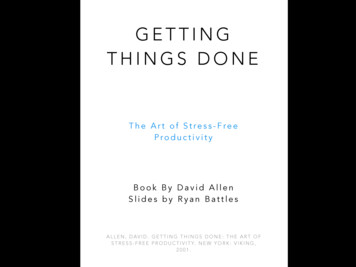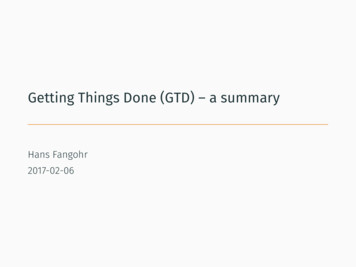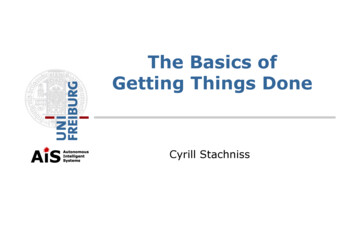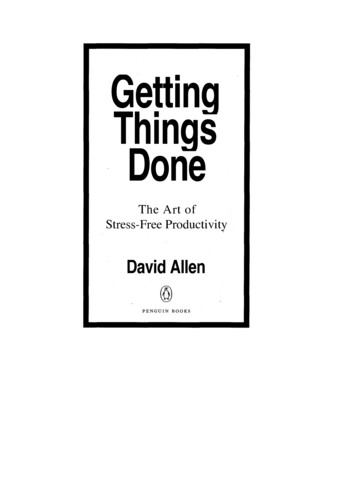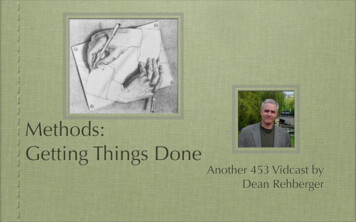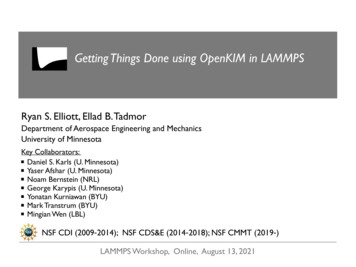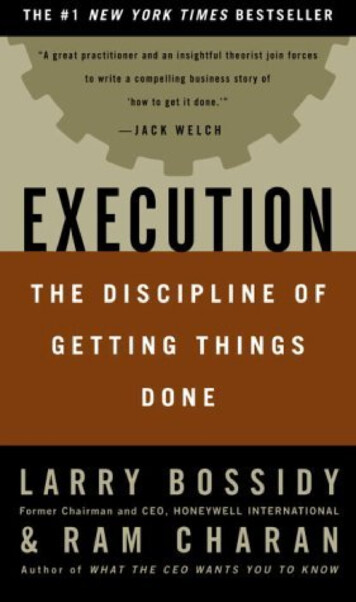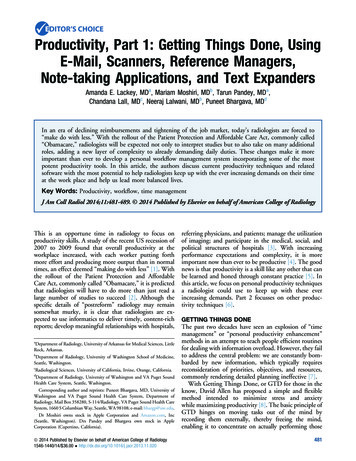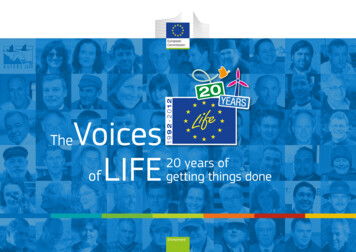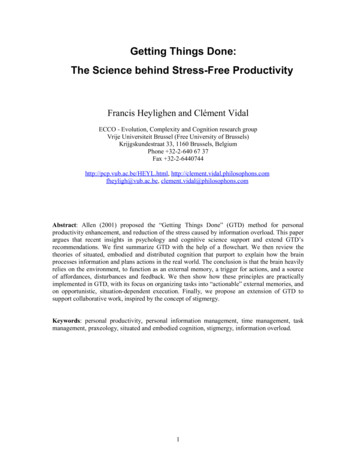
Transcription
Getting Things Done:The Science behind Stress-Free ProductivityFrancis Heylighen and Clément VidalECCO - Evolution, Complexity and Cognition research groupVrije Universiteit Brussel (Free University of Brussels)Krijgskundestraat 33, 1160 Brussels, BelgiumPhone 32-2-640 67 37Fax 32-2-6440744http://pcp.vub.ac.be/HEYL.html, ac.be, clement.vidal@philosophons.comAbstract: Allen (2001) proposed the “Getting Things Done” (GTD) method for personalproductivity enhancement, and reduction of the stress caused by information overload. This paperargues that recent insights in psychology and cognitive science support and extend GTD’srecommendations. We first summarize GTD with the help of a flowchart. We then review thetheories of situated, embodied and distributed cognition that purport to explain how the brainprocesses information and plans actions in the real world. The conclusion is that the brain heavilyrelies on the environment, to function as an external memory, a trigger for actions, and a sourceof affordances, disturbances and feedback. We then show how these principles are practicallyimplemented in GTD, with its focus on organizing tasks into “actionable” external memories, andon opportunistic, situation-dependent execution. Finally, we propose an extension of GTD tosupport collaborative work, inspired by the concept of stigmergy.Keywords: personal productivity, personal information management, time management, taskmanagement, praxeology, situated and embodied cognition, stigmergy, information overload.1
IntroductionOur present society is characterized by quickly growing complexity and change: opportunities,constraints, and objectives are in a constant flux. Managing the situation requires gathering andprocessing an incessant stream of potentially relevant information. As such, most of our day-today activities fall under the heading of knowledge work (Drucker, 1973). But how can weefficiently organize such heavily information-dependent work? While there is a large andestablished literature on how to organize traditional physical activities, such as industrialprocesses, the literature on knowledge management is as yet much less well developed, andmostly concerns the static storage and reuse of existing knowledge rather than the processing ofincoming information. The extensive literature on information processing, on the other hand,mostly concerns computer systems rather than human information processing.Some aspects of human information processing, such as decision-making, projectplanning and problem solving, have been well investigated. However, the corresponding theoriesare not really helpful to cope with the information explosion, since they generally assume a givenrange of possibilities from which the best possible one is to be chosen. However, in a situationwhere new information may arrive by the minute, both the relevant options and the criteria fordeciding between them are constantly changing. This makes formal optimization methodsbasically useless in day-to-day knowledge work. As Simon (1997) pointed out long ago,rationality is bounded: we never have the full information needed to make optimal choices.But Simon’s alternative strategy of “satisficing” is flawed too: a choice that issatisfactory now, may not appear so good anymore when new information comes in. In practice,people follow a strategy of “bettering”: choosing what seems best from the available options now,but being ready to switch to something better when new information arrives. This opportunisticmode of decision-making is pervasive in today’s fast-paced and uncertain world. However, itslack of a clear focus makes it likely that people would not really know what to aim for, what todo, and what not to do. Moreover, the constant bombardment with new information means thatprevious plans, decisions and relevant data are often forgotten or neglected.The last two decades have seen an explosion of methods for “time management”, “taskmanagement”, or “personal productivity enhancement” that try to teach knowledge workersefficient routines for dealing with this overload of ever changing demands (e.g. Covey, Merrill &Merrill, 1994). Most of the recommendations concern concrete tools and techniques, such asinstalling spam filters, using personal organizers, sharing calendars, etc. Insofar that they look atthe wider picture, however, they tend to remain within the optimization paradigm: they suggestfirst to formulate clear objectives or priorities (optimization criteria), and then to order thedifferent tasks according to (a) how much they contribute to the priorities, (b) how much time,effort or other resources you need to invest in them. The recommendation is then to focus on thetasks that contribute maximally to the chosen objectives while requiring minimal resources.Although this strategy may seem self-evident, it does not take into account the fact thatfor knowledge work both priorities and resources are in general ill defined and constantlychanging. The reason is that information, unlike material resources, is not a conserved quantity: itcan appear (be discovered or communicated) or disappear (become outdated) at any moment. Forexample, an engineer planning the construction of a bridge can be pretty confident that theamount of concrete and steel necessary for the construction will not suddenly change. On theother hand, an author planning to write a book about how to use this great new communicationsoftware may suddenly find out that the software has a fatal security flaw, or that another writerhas just finished a comprehensive treatment of the same subject. If that author had planned hercomplete work schedule around the book project, she would have to start her planning fromscratch. More generally, applying an optimization strategy to knowledge work may producerather than reduce stress, as people worry about what priorities to accord to different alternatives,and then feel guilty or disoriented when they have not managed to follow their own prescriptions2
because of unforeseen changes.The personal productivity consultant David Allen (2001) has proposed a fundamentallydifferent approach. Based on years of experience in teaching knowledge workers how to deal withtheir backlog of unprocessed issues, the method is known as “Getting Things Done”, or GTD forshort. GTD is intended to minimize stress and anxiety while maximizing productivity—in thesense of maximizing the number of useful tasks performed, not in the sense of maximallyachieving a given objective. The method has become remarkably popular in a very short time.According to the Amazon web bookshop, in October 2007 Allen’s book ranked number one inthe bestseller lists for both the domains “time management” and “business: health and stress”. Atthe same time, a search via Google found more than a million web pages referring to thismethodology. Numerous software applications and adaptations of existing software have beencreated to help people implement GTD in their daily life (Wikipedia contributors, 2007). In spiteof the many testimonials that GTD works in practice, however, as yet no academic papers haveinvestigated this method. A search (October 2007) for articles referring to (Allen, 2001) turned upa mere 14 documents, none of which discusses the method in any detail.The present paper intends to fill this gap in the scientific literature. While it would beinteresting to test GTD empirically, e.g. by comparing the productivity of people using GTD withthe one of people using different methods, this is intrinsically difficult. The reason is that becauseGTD does not embrace explicit priorities or optimization criteria, there is no obvious standard bywhich to measure expected productivity enhancements. A simpler approach may be subjectiveevaluation: how satisfied with their work are GTD users compared to users of other methods?However, this will still teach us little about precisely how and why GTD is supposed to work.The present approach has chosen to address this last issue from a theoretical angle, starting fromrecent insights in cognitive science and cybernetics.We wish to view GTD and its proposed theoretical foundation as a first step towards aconcrete praxeology, i.e. a theory of practical action, with specific application to knowledgework. A praxeology has been recognized by the philosopher Leo Apostel as one of thefundamentals components of a worldview (Aerts et al., 1994). Such a theory is independent ofany specific goals or values: these are chosen by the individuals performing the actions. In GTD,however, the implicit value is to maximize productivity, i.e. to do more (tasks) with less (time,effort, resources).In our present information society, mental resources in particular tend to be strained.Indeed, in Simon’s (1971, p. 40) memorable phrase, “a wealth of information creates a poverty ofattention”. Given that the amount of attention that we can devote to our work is finite, a growingamount of information clamoring for our attention must at a certain moment produce an overload,where a number of (potentially important) items simply can no longer be processed. GTD isintended to facilitate this unavoidable process of selectively ignoring demands while remainingmaximally in control of the situation. Although the method is rooted in practical experience, wewill try to show that its success can be justified on the basis of solid theoretical foundations. Todo that, we will need to review what the most recent theories about cognition and the brain tell usabout information processing in the real world—as opposed to an abstract realm of logic andrationality. But first we need to outline the basic principles of GTD.3
The GTD method: summaryGTD is a simple and flexible method for managing your day-to-day tasks or activities, so as tomaximize personal productivity. The intended result of applying GTD is being able to keep upwith a high workflow in a relaxed manner. The main principle is to get everything that is naggingyou out of your mind and into a trusted external memory (file system), so that you can stayfocused on what you actually have to do now, rather than on various ideas, plans andcommitments for later. To achieve this, GTD provides a compilation of tips and tools, organizedaround a central flowchart, as depicted in Fig. 1. Organized people will certainly already usecalendars, to-do lists, note-taking devices, and other tools. What GTD adds, however, is a methodfor using those tools systematically together. Allen distinguishes five basic stages in our work:We (1) collect things that command our attention; (2) process what they mean and what to do with them; and(3) organize the results, which we (4) review as options for what we choose to (5) do. (Allen, 2001, 24)Collect (1)The first phase is to collect everything that catches your attention as potentially relevant to youractivities, whatever its subject, importance or degree of urgency. This includes incoming letters,emails, phone calls, reports, articles from magazines, agenda items, suggestions and requestsfrom other people, and personal ideas and memories. For the collecting process, you need one ormore collection tools, which can be physical (trays, folders, notebook, etc.), or electronic (emailapplication, outliner, or word processor, on a computer or a PDA). These together define your“in-basket”.Collection is just the first step: to gain control over the collected materials, you need toempty the in-basket regularly. Emptying means deciding what to do with—not actually doing—the items in the collection. This happens by processing and organizing the items one by one.Process (2) & Organize (3)The processing and organizing phases are summarized in the flowchart (Fig.1).4
Figure 1: a flowchart depicting the GTD process for organizing and processing incoming “stuff” intoaction categories (elaborated from (Allen, 2001, p. 32)). Rectangles represent actions, diamondsrepresent decision points, stacks represent external memories (lists, folders, files, ) in whichreminders are stored. Continuous arrows represent the immediate sequence of processing; brokenarrows represent delayed processing, during a review of an external memory; dotted lines representfollow-up processes left implicit in GTD, but whose importance will become clear in the explanation ofFig. 2. The process starts by taking one item out of the In-basket (top-left), and then follows the arrowsdepending on the answers to the questions. It ends when the item is classified in an external memory orthe corresponding action is performed. The most important actions are likely to end up on the bottomright.5
The sequence of decisions to be made starts from the top left of the flowchart and proceedsdownwards. The first question to ask is: “What is this stuff?” Note that “stuff” is a catchall word,which can refer to an email, something at the back of your mind, a note, a voice-mail, a scrapfrom a newspaper, etc., i.e. any item that has been collected. More precisely, the crucial questionis: “Is it actionable?”, i.e. does it require you to perform an action? if it is not actionable, there are three possibilities:o eliminate the item if you really will not use it (i.e. throw it in the trash bin);o incubate the item for possible implementation later (i.e. store it in aSomeday/maybe file that you will review at a later time);o reference the item if it does not require action but may need to be consulted later(i.e. store it in a Reference file, which is organized so that items are easy toclassify and retrieve). if it is actionable, then you have to decide, “What is the next physical action?”o if there is more than one action required, store it in your Projects list.o if the action requires less than two minutes, it is not worth the effort of entering itinto the system: better perform it immediately.o if you are not the best person to do it, deleg
Getting Things Done: The Science behind Stress-Free Productivity Francis Heylighen and Clément Vidal ECCO - Evolution, Complexity and Cognition research group Vrije Universiteit Brussel (Free University of Brussels) Krijgskundestraat 33, 1160 Brussels, Belgium Phone
